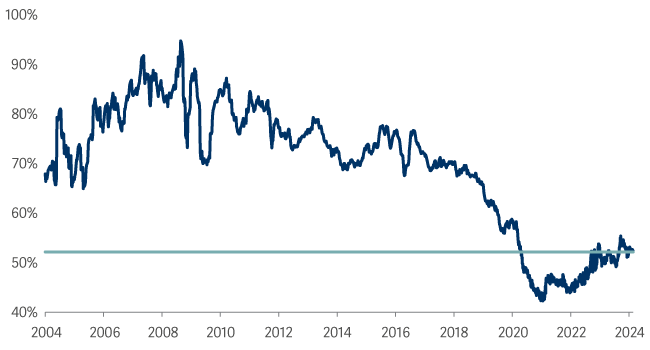Artemis SmartGARP Global Equity Fund update
Raheel Altaf and Peter Saacke, managers of the Artemis SmartGARP Global Equity Fund, report on the fund over the quarter to 31 March 2024 and their views on the outlook.
Source for all information: Artemis as at 31 March 2024, unless otherwise stated.
- The fund rose 13%, ahead of its benchmark the MSCI World Index, which rose 9.2%.
- Stock picking drove the outperformance, with holdings in banks particularly helpful.
- Low fund turnover; still most overweight banks, insurance and energy and underweight tech, other financials and industrials.
- Also still prefer Europe (not least UK), emerging markets and Japan to US equities.
- The fund sticking to its tilt towards value and low risk.
- Pockets of opportunity remain.
Performance – Eclectic mix of winners lets low-risk fund outperform a rising market
Global equities continued to perform well on the back of robust economic data and hopes of an easing of monetary policy later this year.
During the quarter, the MSCI All Country World index rose by 9.2%, led by US and Japanese equities. European and especially Asian and emerging market equities lagged. At the sector level, semiconductor stocks were once again among the strongest performers, though this quarter they were joined by energy and banks stocks. Technology hardware and software stocks were the biggest laggards by contrast.
While the continued outperformance of US equities was a headwind for our fund, this was offset by the tailwind from the stronger performance of banks and energy. The fund’s outperformance was thus mostly due to effective stock picking, leaving the fund up 13% versus a benchmark return of 9.2%.
The fund’s biggest contributors to performance in Q1 were an eclectic bunch. They were led by our investment in Dell Technologies, with Chinese oil producer CNOOC, US insurer Hartford Financial Services, Meta, UK defence company BAE Systems and building service provider Comfort Systems USA also contributing well. Not owning any shares in benchmark heavyweights Apple and Tesla, which both declined, also added meaningfully to relative performance.
On the negative side…
On the negative side, not owning any shares in semiconductor leader Nvidia once again stood out as the company’s shares rose over 80% in Q1. Similarly, not owning any Eli Lilly also held back performance. The only meaningful unsuccessful investment was our position in Perion Networks, an Israeli tech stock, which released disappointing Q4 results and guidance.
Activity – Adding to autos at expense of travel and leisure
Changes in the fund were minimal, largely due to most of our holdings reporting results that supported our case for investing in them.
At the margin, we increased our holdings in the auto sector by adding to our existing positions in GM and Hankook Tires (South Korea) and adding a new position in BMW. These purchases were financed from the sales of our shares in McDonalds and HSBC.
Given the low turnover, it stands to reason that the fund’s principal exposures are unchanged. Regionally we continue to be overweight in European equities (24% versus 16% benchmark weight), emerging markets (21% of fund versus 11% benchmark weight) and Japan (6% versus 5%) and underweight especially in the US (45% versus 63%). At the sector level, we still prefer banks, insurance and energy and remain very underweight technology and, to a lesser extent, financial services and industrials
Last, but not least, the fund’s tilt towards 'value' stocks, that is, those trading on below-market valuations, remains very pronounced. At the end of March, the fund was trading on an average price-earnings ratio of 9.4 versus the benchmark at 17.6. This 47% discount to the market remains very low in the context of the 20 years the present manager has managed the fund (see chart below).
Relative price-earnings ratio of SmartGARP Global Equity Fund vs. market

Outlook – Plenty of optimism priced into parts of the market while pockets of opportunity remain
The global equity market’s strength keeps defying the sceptics who worry about the delayed impact of the tightening of monetary policy. Yet the fact that global equity benchmarks continue to make new all-time highs hides from view how disparate the performance of different segments of the market remains. While the US makes new highs seemingly every other week, valuations in the UK, parts of continental Europe and especially in emerging Asia remain at their lowest relative levels in decades.
Since our fund is heavily exposed to these unpopular parts of the market, we remain sanguine about the outlook for our fund even if we are not particularly optimistic about the outlook for markets in general. Meanwhile, our approach remains focussed on what companies are telling us regarding their individual business's prospects to ensure that the fund’s positioning reflects this in a timely manner. Against this backdrop, our fund’s bias towards companies with resilient earnings and healthy balance sheets, which, as an additional layer of protection, trade on below-average valuations, continues to be warranted, in our view.
Source: Lipper Limited/Artemis from 31 December 2023 to 31 March 2024 for class I accumulation GBP.
All figures show total returns with dividends and/or income reinvested, net of all charges.
Performance does not take account of any costs incurred when investors buy or sell the fund.
Returns may vary as a result of currency fluctuations if the investor's currency is different to that of the class.
Classes may have charges or a hedging approach different from those in the IA sector benchmark.
Benchmarks: MSCI AC World NR; A widely-used indicator of the performance of global stockmarkets, in which the fund invests. IA Global NR; A group of other asset managers’ funds that invest in similar asset types as this fund, collated by the Investment Association. These benchmarks act as ‘comparator benchmarks’ against which the fund’s performance can be compared. Management of the fund is not restricted by these benchmarks.

